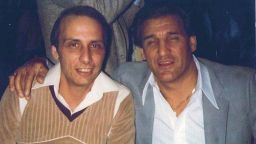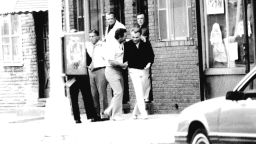Story highlights
Recordings made in 2011 by key witness appear to reference 1978 Lufthansa heist
The tapes played at federal trial in New York also highlight plight of aging wise guys
In 2008, a lifelong Mafia associate picked up the phone and dialed a random number at the FBI in New York.
“I’d like to cooperate,” Gaspare Valenti, now 68, recalled saying on the phone to a woman named Nora. She happened to head a federal law enforcement squad investigating the Bonanno crime family.
“I have remorse in me and need ways to support my family,” Valenti said in the call.
For the next five years, Valenti arranged to receive about $3,000 a month to record conversations, including some with his first cousin, Vincent Asaro, an alleged Bonanno family captain.
The recordings were critical in bringing federal charges, more than 30 years after the crime, against five alleged Bonanno crime family members in the infamous Lufthansa heist that helped inspire part of the 1990 film “Goodfellas.”
The hours of wire and telephone recordings have been played in Asaro’s federal trial in Brooklyn on a string of charges that include murder, racketeering and the 1978 airport heist.
With the tapes, prosecutors have sought to portray Asaro, 80, as an aging and broke wise guy, insecure of his position within the family and nostalgic for the days when an illegal and lucrative ecosystem controlled large swaths of New York with a degree of impunity.

Asaro’s plight highlights the struggles of many aging wise guys, desperate to eke out a living while trying to remain relevant in a rapidly changing underworld, according to experts.
“It’s no longer like it used to be,” said Anthony DeStefano, a journalist who has covered organized crime for more than three decades and wrote “Gangland New York: The Places and Faces of Mob History.”
“Somebody once told me the best job category you could have now is to be a government witness. … You get some security from jail. You get some money. And you may get relocated and get a new life altogether.”
‘Down but not out’
Government crackdowns have thinned the Mafia ranks in recent decades.
Major arrests and convictions in the 1980s and 1990s crippled the mob. If they didn’t get whacked first, top bosses faced multiple prosecutions and long prison terms. Among the big names to take perp walks over the years were John Gotti, Joseph Massino and Vincent Gigante.
The prosecutions “made a significant dent in the mob activity,” said Kelly Langmesser, an FBI spokeswoman in New York. “The mob can be down, but not out. They always keep coming back.”
Former Gambino family boss Gotti died of cancer in federal prison in 2002 while serving a life sentence for murder and racketeering. Gotti became the godfather of the Gambino family in 1985 and, shortly after, survived three criminal cases on charges ranging from assault to racketeering, before the feds finally convicted him of five murders in 1992.The testimony of a former friend and Gambino hitman, Sammy “the Bull” Gravano, helped bring Gotti down.

Massino, a member of the Bonanno family, agreed to cooperate with prosecutors and received two life sentences in 2005 after pleading guilty to involvement in eight mob murders. He later testified against multiple mob bosses.
Vincent Gigante, a boss in the Genovese crime family, died in prison in 2005 after his 1997 conviction for several crimes including racketeering and conspiring to murder in aid of racketeering.
“They’re either dead like Gotti, or they turned government witness like Joe Massino, or they’re in prison,” DeStefano said.
‘The old-time stuff’ is gone
For those who remain on the street, the old-time rackets began to shrink.
“I’m not saying the mob can’t do anything or can’t hurt you,” DeStefano said. “But the big rackets have been sort of tied up by the feds and the police. They don’t exist. The big labor racketeering rackets, the big concrete syndicates, the big garment industry rackets don’t exist anymore. You have local businesses, like the restaurants, maybe an auto body shop, that could be muscled by the mob. That’s where it still works. But the old-time stuff, forget it.”
After the September 11 terrorist attacks, some FBI squad personnel were shifted from organized crime to Asian and Russian syndicates. Counterterrorism and cybercrime units were created and beefed up with agents who previously worked in the organized crime division, Langmesser said.
“Even though our priorities changed after September 11 and more ethnic crime groups grew in the city … our arrest records show that we are still making cases against them,” Langmesser said.
In 2011, for instance, the FBI arrested 120 mobsters, she said.
No mob retirement plan
Valenti was one former mobster who apparently found some security as – in the vernacular of the mob – a rat.
Back when he rolled with Mafia big shots, Valenti testified in federal district court, he was at John F. Kennedy Airport one night 37 years ago during the Lufthansa heist.
Valenti admitted to cutting open a gate so a van could pass through and enable associates to steal more than $5 million in cash and $1 million in jewelry, according to testimony.
At the time of Valenti’s call to the FBI, no charges had been filed against anyone for what was then the biggest heist in American history.
Like many aging mobsters, Valenti was broke. The mob has no retirement plan. He had spent years borrowing money, gambling it away and rarely paying it back. Now, he had a new baby girl to support.
“They are basically living sort of scheme to scheme,” DeStefano said of the old mobsters.
‘We did it to ourselves’
The recordings played at Asaro’s trial picked up multiple instances in which the defendant and Valenti speak about earning money and then gambling away large sums.
“What a shame. Look what we came down to,” Valenti told Asaro in one recorded conversation.
“It’s life. We did it to ourselves,” Asaro replied. “It’s a curse with this f*****g gambling.”
A few months later, Asaro told Valenti that he had just played Texas Hold ‘em poker for the first time and was happy with his wins.
“I won $200. $280, the pot was, uh, $280 – I had to pay $80, I had to buy in again.”
The cousins reminisced about a card game years earlier when Asaro won a $37,000 pot.
“Those were the games, man. That’s when money was loose,” Valenti said.
“I gave the kid a thousand-dollar tip that night,” Asaro said. “We used to play that at John’s club, $1,000 a hand.” Valenti testified that the reference was to Gotti.
Michael Franzese, who describes himself as a former boss with the Colombo organized crime family, called Asaro “a dinosaur,” part of a legion of “made guys” who were not real earners in their day and were now forced to scrounge around for scores.
“Things you were able to make money on aren’t available anymore,” Franzese told CNN. “They don’t have the same unions. There aren’t the same card games and runners. Neighborhoods have dried up with a lot of the Italian dominance we once had.”
‘They’re gonna take my badge away’
In the taped conversations, Asaro appears to reveal his insecurity with his place in the family ranks. In September 2011, he told Valenti he was worried about his “badge,” or status, being knocked down because he had lashed out against associates.
“They’re gonna throw me outta the place … they’re gonna take my badge away, you’re gonna see. It’s gonna happen. I know it’s gonna happen,” Asaro said.
“Cause I had a big beef last week,” he continued. “Screaming at them. ‘I want my f*****g money.’ I’m broke, I’m getting like a f*****g animal. Two wise guys – I know they’re gonna be talking.”
In November 2011, the cousins spoke about a New York boss who was killed in Canada. Asaro suggested to Valenti that he might be losing power and influence.
“I don’t know what the f**k is going on in Canada. I don’t even know what’s going on in Ozone Park,” Asaro told Valenti.
On cross-examination, Valenti told Asaro attorney Elizabeth Macedonio he had met with “six or seven” FBI agents “more than 150 times” since he began cooperating.
Asaro, a tattoo of the Mafia mantra “Death before dishonor” tucked beneath his shirt, sat in court and gasped in disbelief.
“More than 150?” he repeated to himself, shaking his head.
Asaro’s lawyers have said the government’s case against him is built on the testimony of criminals who cut deals with the prosecution.
In opening statements, Asaro attorney Diane Ferrone called the government’s witnesses “criminal cooperators” with a motive to lie. She noted Valenti’s history of borrowing money he couldn’t pay back and accused him of cooperating “to make a buck. … His latest con victim is the U.S. government.”
Many old-line gangsters remain adrift and unmoored from the old life, “a life that doesn’t exist anymore,” said DeStefano, the mob expert.
CNN’s Yon Pomrenze contributed to this report.

